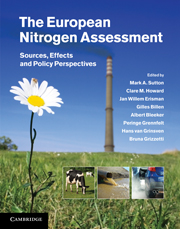Book contents
- Frontmatter
- Contents
- List of contributors
- Foreword
- Summary for policy makers
- Technical summary
- 1 Assessing our nitrogen inheritance
- Part I Nitrogen in Europe: the present position
- Part II Nitrogen processing in the biosphere
- Part III Nitrogen flows and fate at multiple spatial scales
- Part IV Managing nitrogen in relation to key societal threats
- 17 Nitrogen as a threat to European water quality
- 18 Nitrogen as a threat to European air quality
- 19 Nitrogen as a threat to the European greenhouse balance
- 20 Nitrogen as a threat to European terrestrial biodiversity
- 21 Nitrogen as a threat to European soil quality
- Part V European nitrogen policies and future challenges
- Glossary
- Index
- References
19 - Nitrogen as a threat to the European greenhouse balance
from Part IV - Managing nitrogen in relation to key societal threats
Published online by Cambridge University Press: 16 May 2011
- Frontmatter
- Contents
- List of contributors
- Foreword
- Summary for policy makers
- Technical summary
- 1 Assessing our nitrogen inheritance
- Part I Nitrogen in Europe: the present position
- Part II Nitrogen processing in the biosphere
- Part III Nitrogen flows and fate at multiple spatial scales
- Part IV Managing nitrogen in relation to key societal threats
- 17 Nitrogen as a threat to European water quality
- 18 Nitrogen as a threat to European air quality
- 19 Nitrogen as a threat to the European greenhouse balance
- 20 Nitrogen as a threat to European terrestrial biodiversity
- 21 Nitrogen as a threat to European soil quality
- Part V European nitrogen policies and future challenges
- Glossary
- Index
- References
Summary
Executive summary
Nature of the problem
Reactive nitrogen (Nr) is of fundamental importance in biological and chemical processes in the atmosphere–biosphere system, altering the Earth's climate balance in many ways. These include the direct and indirect emissions of nitrous oxide (N2O), atmospheric Nr deposition and tropospheric ozone formation (O3), both of which alter the biospheric CO2 sink, Nr supply effects on CH4 emissions, and the formation of secondary atmospheric aerosols resulting from the emissions of nitrogen oxides (NOx) and ammonia (NH3).
Human production and release of Nr into the environment is thus expected to have been an important driver of European greenhouse balance. Until now, no assessment has been made of how much of an effect European Nr emissions are having on net warming or cooling.
Approaches
This chapter summarizes current knowledge of the role of Nr for global warming. Particular attention is given to the consequences of atmospheric Nr emissions. The chapter draws on inventory data and review of the literature to assess the contribution of anthropogenic atmospheric Nr emissons to the overall change in radiative forcing (between 1750 and 2005) that can be attributed to activities in Europe.
The use of Nr fertilizers has major additional effects on climate balance by allowing increased crop and feed production and larger populations of livestock and humans, but these indirect effects are not assessed here.
- Type
- Chapter
- Information
- The European Nitrogen AssessmentSources, Effects and Policy Perspectives, pp. 434 - 462Publisher: Cambridge University PressPrint publication year: 2011
References
- 48
- Cited by



